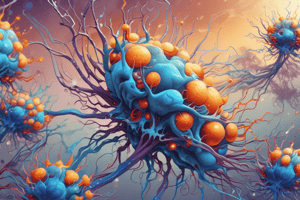Podcast
Questions and Answers
What is the effect of repeated low frequency stimulation of the sensory neuron?
What is the effect of repeated low frequency stimulation of the sensory neuron?
- Postsynaptic depression (correct)
- Synaptic facilitation
- Synaptic potentiation
- Short-term post-synaptic depression
What characterizes Homosynaptic Depression?
What characterizes Homosynaptic Depression?
- Increased sensitivity of Glu receptors
- Presynaptic mechanism of plasticity (correct)
- Increased vesicle release with each trial
- Increased glutamate release
What leads to Short Term Synaptic Potentiation?
What leads to Short Term Synaptic Potentiation?
- Rapid depletion of active vesicles
- Increased Ca+ accumulation (correct)
- Decreased influx of calcium
- Unchanged vesicle exhaustion
What is the mechanism underlying synaptic facilitation?
What is the mechanism underlying synaptic facilitation?
How does calcium contribute to Short Term Synaptic Potentiation?
How does calcium contribute to Short Term Synaptic Potentiation?
What happens to the vesicle pool following a habituation protocol?
What happens to the vesicle pool following a habituation protocol?
What is the purpose of the ATP-dependent priming reaction in synaptic vesicles?
What is the purpose of the ATP-dependent priming reaction in synaptic vesicles?
Which mechanism is the most rapid for reusing vesicles after transmitter discharge?
Which mechanism is the most rapid for reusing vesicles after transmitter discharge?
What characterizes the classical pathway of vesicle retrieval?
What characterizes the classical pathway of vesicle retrieval?
How does the bulk retrieval pathway differ from the classical pathway?
How does the bulk retrieval pathway differ from the classical pathway?
Which step immediately follows the ATP-dependent priming reaction in the synaptic vesicle cycle?
Which step immediately follows the ATP-dependent priming reaction in the synaptic vesicle cycle?
What happens during reversible fusion pore mechanism in vesicle reuse?
What happens during reversible fusion pore mechanism in vesicle reuse?
What is the mechanism underlying short-term habituation in the gill-withdrawal reflex of Aplysia?
What is the mechanism underlying short-term habituation in the gill-withdrawal reflex of Aplysia?
What is the mechanism by which each quantum of transmitter released from the presynaptic terminal affects the postsynaptic potential?
What is the mechanism by which each quantum of transmitter released from the presynaptic terminal affects the postsynaptic potential?
Which of the following statements best describes the relationship between the amplitude of the EPSP and the number of quanta of transmitter released?
Which of the following statements best describes the relationship between the amplitude of the EPSP and the number of quanta of transmitter released?
Which of the following is NOT a factor contributing to synaptic plasticity in the gill-withdrawal reflex of Aplysia?
Which of the following is NOT a factor contributing to synaptic plasticity in the gill-withdrawal reflex of Aplysia?
What is the purpose of the siphon in Aplysia?
What is the purpose of the siphon in Aplysia?
Which of the following structures is involved in the gill-withdrawal reflex of Aplysia?
Which of the following structures is involved in the gill-withdrawal reflex of Aplysia?
Flashcards are hidden until you start studying
Study Notes
Synaptic Vesicle Cycle
- Filled vesicles dock at the active zone and undergo an ATP-dependent priming reaction to become competent for calcium-triggered fusion.
- After discharging their contents, synaptic vesicles are recycled through clathrin-mediated endocytosis or by endosomes.
Vesicle Retrieval Mechanisms
- Reversible fusion pore: rapid mechanism for reusing vesicles, requiring only closure of the fusion pore.
- Classical pathway: excess membrane is retrieved through endocytosis using clathrin-coated pits.
- Bulk retrieval pathway: excess membrane reenters the terminal by budding from uncoated pits.
Synaptic Plasticity
- Habituation: decreased response to repeated stimulation, resulting in fewer docked vesicles, but recovers after hours.
- Homosynaptic depression: decreased transmitter release, indicating a presynaptic mechanism of plasticity.
- Short-term synaptic depression: due to presynaptic depletion of active vesicles.
- Calcium plays multiple roles in synaptic facilitation and depression.
Synaptic Facilitation and Potentiation
- Synaptic facilitation: results from Ca+ accumulation, increasing recruitment, docking, and release efficiency.
- Short-term synaptic potentiation: higher frequency stimulation causes rapid and sustained influx of calcium, enhancing vesicle release.
Aplysia and Habituation
- Habituation: decrease in intensity of reflexes in response to repeated electrical stimulation of motor pathways.
- Experimental setup: Aplysia's gill-withdrawal reflex, with repeated stimulation leading to habituation.
- Simplified circuit: shows key elements of the gill-withdrawal reflex and sites involved in habituation.
Studying That Suits You
Use AI to generate personalized quizzes and flashcards to suit your learning preferences.




